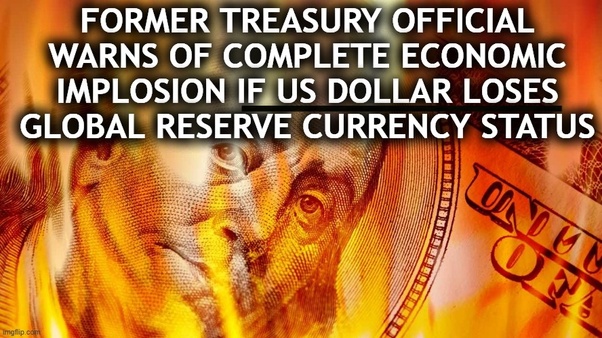Digital Zeitgeist – The Dollar on the Brink: Is the World Ready for the Unravelling of America’s Financial Supremacy?
As we scrutinise the world’s political stage, a prevailing question reverberates through the corridors of power: “Will the US dollar maintain its hegemony as the dominant currency for global economic and financial transactions?” This precarious landscape finds the United States balancing relations with heavy hitters like Russia, China, and the confluence of BRICS nations while grappling with internal economic and political turmoil.
The BRICS Bloc and the Vision for a New Monetary Order
In the foreground stands Luiz Inácio Lula da Silva, the Brazilian president championing the call for a common currency amongst BRICS nations — an amalgamation of Brazil, Russia, India, China, and South Africa. Lula envisages a world where the blossoming power of the BRICS nations commands a rightful seat at the monetary helm, edging away from dollar dependency. The subtext reveals an ambitious narrative to deconstruct the prevalent US dollar monopoly and foster a financial ecosystem that mirrors the burgeoning influence of the BRICS bloc on the global stage.
Russia’s Great Divergence
To illuminate the complexity of the scenario, one must delve into Russia’s conscious drift from the dollar. Anchored in the illegal annexation of Crimea in 2014, Moscow’s fears materialised as sanctions ensnared them, pushing them further from the dollar’s grip. The underlying apprehension manifests in the weaponisation of the dollar, a technique wielded proficiently by the US, consequently encouraging other nations to emulate Russia in sidestepping the dollar to avoid potential repercussions.
The Yuan Ascending: China’s Grand Strategy
Parallel to this trajectory, we witness China nurturing its currency, the yuan, not merely as a countermeasure to escalating tensions with the US but as an emblem of its burgeoning global influence. This reflects a profound undercurrent of ambition, revealing a meticulously carved path towards economic and financial self-sufficiency, consequently questioning the viability of a dollar-dominated world amidst two economic titans continually at odds.
The Sterling Precursor: A Lesson from History
To prognosticate the future, we find an ally in history, the chronicle of the British pound sterling serving as a poignant tutor. Once a paragon of economic might, the sterling gradually ceded its status to the dollar, a decline engendered by a myriad of factors including immense war debt and reduced economic potency post the World Wars.
By the early 1920s, despite its depleted state, sterling successfully clung to its international status, a triumph attributed to stringent economic policies fostered by the stalwart, Winston Churchill, then chancellor of the exchequer. However, by the end of World War II, the UK’s burgeoning debt and commitment to full employment necessitated policies antithetical to international currency status, a manoeuvre triggering the decline of sterling’s global stature, a position further undermined by geopolitical undertakings such as the Suez crisis in 1956.
The US at Crossroads: The Road Ahead
As we turn our gaze towards the contemporary era, we recognise that the dollar’s future hinges not solely on external geopolitics but significantly on the actions of its issuer, the US. A nation at a crossroads, the responsibility to uphold the dollar’s primacy rests on its shoulders, contingent on its adeptness in steering clear of unproductive debt-ceiling showdowns and maintaining economic stability.
Conclusion: The Imperative of Prudent Leadership
In summary, the future is a canvas yet to be painted. The pages of history elucidate that the maintenance or relinquishment of an international currency’s dominance is profoundly influenced by the strategic choices of the issuing country.
At this juncture, the US finds itself wielding the brush that could colour its economic canvas with strokes of stability and continuity or mar it with hues of decline. To retain its dominant position, it becomes incumbent upon the US to foster policies grounded in economic sagacity and political prudence. The onus is on the American leadership to eschew partisan brinkmanship and focus on nurturing an environment of stability and growth.
The global economy stands at a precarious junction, a phase where the international repercussions of a potential decline in dollar dominance could engender a seismic shift in economic landscapes, steering nations towards unknown terrains of financial operations.
Moreover, there exists a tangible necessity for a cohesive, strategic approach to facilitate economic synergies globally, one that builds upon the strengths of existing monetary frameworks while embracing the potentials inherent in emerging economic blocs. The objective remains to foster a financial architecture that remains resilient amidst geopolitical tensions, one that safeguards the global economic system from unprecedented shocks and stresses.
Therefore, the international community stands watchful, a sentinel to the unfolding narrative, the chapters of which will be authored by policy choices, geopolitical dynamics, and economic strategies of the US. Only time will render the final verdict on whether the dollar will continue to be the linchpin holding the global economic machinery together, or if the stage is set for a new protagonist to emerge, steering the world towards uncharted financial waters with repercussions echoing through generations to come.
Disclaimer: The views and opinions expressed in this article are those of the author and do not necessarily reflect the official policy or position of GPM-Invest or any other organisations mentioned. The information provided is based on contemporary sourced digital content and does not constitute financial or investment advice. Readers are encouraged to conduct further research and analysis before making any investment decisions.

